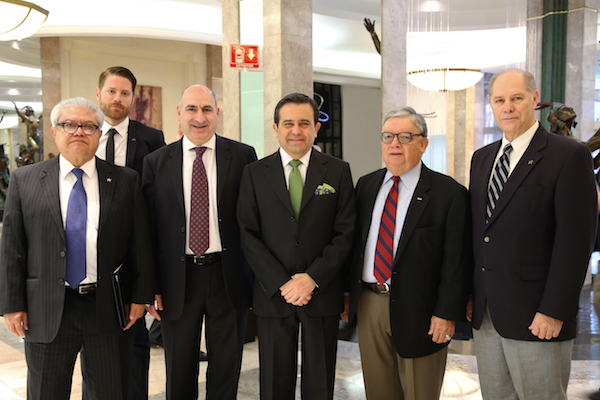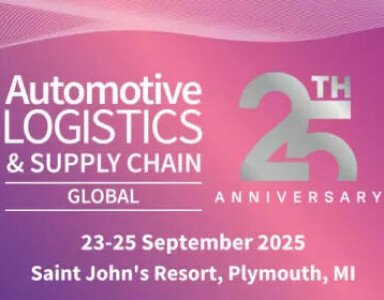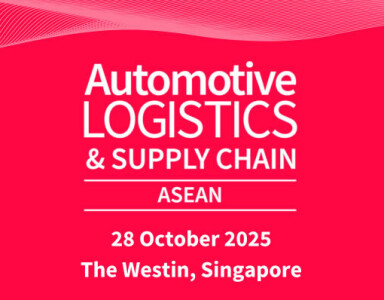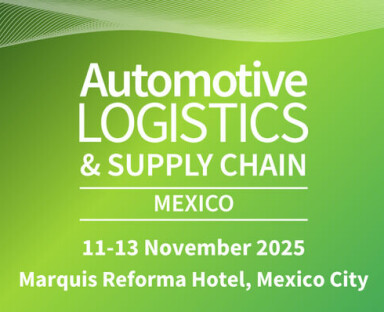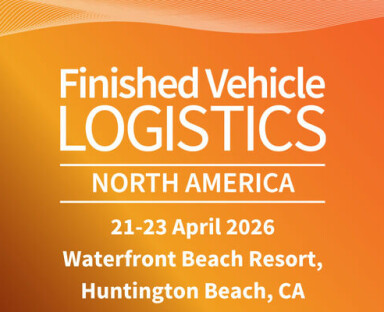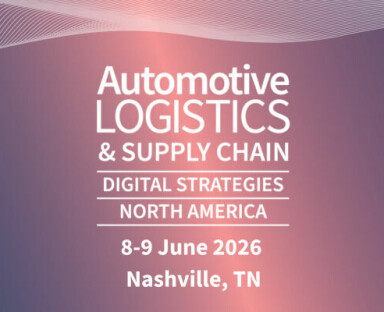Connecting the many Mexicos – conference report

The first Automotive Logistics Mexico conference saw more than 350 delegates discussing how best to manage the country’s vehicle production and export growth. Officials from the economy and transport ministries, the US ambassador, and senior executives pointed to economic and supply chain strengths, as well as weaknesses in infrastructure and education.
Marcus Williams contributed to this report.
After being sworn into office in 2012, the current president of Mexico, Enrique Peña Nieto, spoke of a country moving at two different speeds: one experiencing progress and development, the other living in the past and in poverty. A recent McKinsey report similarly described the Mexican economy as a ‘tale of two Mexicos’, with one highly productive and making competitive advances in industries like the automotive and aerospace, even as other sectors are often fragmented, low tech and part of the informal economy, including aspects of the trucking and warehouse industry.
Anyone who spends time in Mexico will recognise more than two Mexicos: the sprawling metropolis of Mexico City, the Caribbean beaches and Mayan ruins of the Yucatan, the industrialised Bajio, and troubled border cities. Nevertheless, the duality trope remains useful shorthand for understanding the country in the context of its industrial sector: productivity in Monterrey, in the northeast, is ten times higher than in agriculturally dominated Oaxaca, in the south. Likewise, even though Mexico is building new university campuses and the country graduates more engineers each year than Germany, only 26% of the population completes an equivalent high school diploma, and just 10% goes on to university.
Transport infrastructure varies widely too, from well paved, four lane autopistas connecting industrial regions, to the lack of road and rail in many other parts of the country, along with underdeveloped seaports.
There are wide disparities in government and public institutions as well. Even with a reform-focused federal government in power, and with some state governments, including Guanajuato and Nueva Leon, pushing hard to develop industry, education and infrastructure, Mexico is ranked poorly in government effectiveness, transparency and corruption. The alleged complicity of police in the disappearing of student teachers recently in Guerrero, in the south, illustrates these divides all too painfully.
Such gaps in governance, education and infrastructure came to the fore at the first Automotive Logistics Mexico conference. The conference’s keynote speaker, Ildefonso Guajardo, Mexico’s Secretary of the Economy, described his own life in the context of the two Mexicos, especially in skill developments and education. A product of public school education in relatively prosperous Monterrey, he gained a scholarship and was able to study abroad. “If I had been born in Chihuahua, or the hills of Oaxaca, I would have had no chance,” he said. “It is the job of the government today to make sure that Mexico has the same opportunities in education across the country.”
These gaps matter to industry, including the automotive supply chain. Executives spoke of difficulties in finding and retaining skilled staff, with growing worries as the country’s automotive production expands. Hector Gutierrez, the president of Delphi Mexico, pointed to a growing skills gap as a result of poor education, while complex labour laws in Mexico have compounded the issue. Volker Voss, vice-president of operations at Seglo Logistics Schnellecke, which has large logistics and in-plant material handling operations in Mexico, stressed how his company has invested significantly to develop specialised education and training for its staff in an effort to overcome skills shortages and high turnover rates in Mexico.
Follow this link for video recordings of the main sessions from the event
Click the links below for other news stories from the 2015 conference. Check back over the coming days as more stories are added:
- FTAs essential to Mexican growth
- Urgent developments needed at Veracruz
- Ferromex expects to meet capacity demands
- No sense in US-EU FTA without Mexico
- Höegh opens Mexico office
- Supply base set to grow deeper
- Sea change needed for short sea
Review some of our recent coverage of Mexico:
The logistics divide
Along with education, the huge disparities in logistics and infrastructure across the many Mexicos impacts the automotive industry’s production and distribution.
On the one hand, the Mexican automotive industry manages tremendous complexity in the supply chain, including thousands of shipments of production parts, material and finished vehicles through a diverse, international and multimodal supply chain.
For example, both General Motors and Ford have oriented around half of their border flows to rail and intermodal, with the rest moving mainly by truck. According to Gabriel Lopez, the president and chief executive officer at Ford Mexico, the carmaker makes around 7,680 truck deliveries per month (49%), 6,160 intermodal moves (40%), 860 railcar movements (6%), 629 shipments by vessel per month (4%), and 99 by air (1%).
The company also completes 1,600 import operations and 900 export operations each day. For this network, border efficiency is one of Ford’s principal concerns. “For border moves, we need to expedite the crossing and ensure that the material doesn’t need to stop,” said Lopez.
But even with complex networks like Ford’s, Mexico suffers from deficits in its inland and port network. According to Delphi’s Gutierrez, only 10% of Mexico’s 133,000km of paved roads are the four lane autopistas that logistics providers principally use, and most of these have high tolls, especially for trucks.
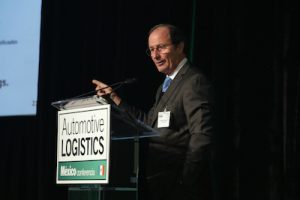
Another issue is customs clearance, for which Mexico is ranked poorly according to international benchmarks as measured by the World Bank. At the US-Mexican border, for example, working hours are much more limited, compared to the 24-hour US-Canadian border.
“The goal is not to have the cargo stopping at all, there should be free flow across the border,” said GM Mexico’s logistics manager, Luis Sandoval.
Rafael Lopez, director of material planning and logistics at Ford Mexico, put port infrastructure as his top concern, as he saw limits in moving both material and finished vehicles through the country’s gateways. Veracruz, the country’s largest general cargo and automotive port, is “saturated”, according to Alejandro Couttolenc, head of commercialisation at the port. Currently, for example, Veracruz cannot berth the longer, post-Panamax vessels that are being ordered by many deep-sea container and ro-ro shipping lines.
Mexico also lacks a specialised, dedicated terminal for ro-ro cargo or finished vehicles, which also holds back processing times and potential value-added work for imported or exported vehicles.
Worries for the future
Beyond its current limits, executives from carmakers and logistics providers expressed significant worries about future capacity and infrastructure, especially for rail, which accounts for around 80% of the vehicle exports that move from Mexico northbound to the US and Canada, as well as a large share of the material flow between the two countries. “We need at least 2,000 more railcars in addition to what we have today as production rises,” said Roberto Zavala, head of Mexico for Wallenius Wilhelmsen Logistics. “Is that really going to happen? We are concerned.”
Zavala called for more short-sea shipping services, however he acknowledged that port capacity as well as shipping services were a constraint. One of the reasons that shipping struggles to be competitive with rail is its less frequent sailings and longer transit time. This is compounded by the fact that the market does not tend to use specialised, smaller ships for short-sea flows in the way that is common in Europe. Instead, shipping lines add port stops onto larger global routes between the Americas, or with Europe and Asia. “In Europe, [short-sea transit time] is measured in hours, not days. In North America, it is measured in days not hours.”
"We need at least 2,000 more railcars in addition to what we have today as production rises. Is that really going to happen? We are concerned" - Roberto Zavala, Wallenius Wilhelmsen Logistics
OEMs also expressed concerns over rail and border capacity, as well as impacts across the supply chain, including for the security of cargo.
“What keeps us up at night? First off it is rail, especially border capacity and congestion,” said Alfonso Rodriguez, Mexico vehicle logistics manager at General Motors. “This also increases risk of vandalism and theft, including for tyres, batteries, key fobs and even tailgates.”
Such theft highlights concerns over theft and security in Mexico, not only near the border but also in the more prosperous central region. Ferromex, one of the country’s two main railways, has more than 2,000 guards to help secure cargo.
Planning for growth
The question is whether these concerns could eventually threaten or slow Mexico’s phenomenal production and export growth expectations. Last year saw record output with 3.22m units of production and 2.6m exports, respectively. Forecasts are rising following recent announcements for new plants from BMW, Mercedes-Benz, Infiniti and Kia; GM is also investing billions with plans to double production by 2018. Guajardo indicated that other Japanese carmakers, as well as an American one, were close to making new announcements. Production is now expected to reach 5m units by the end of the decade, with around 4m slated for export.
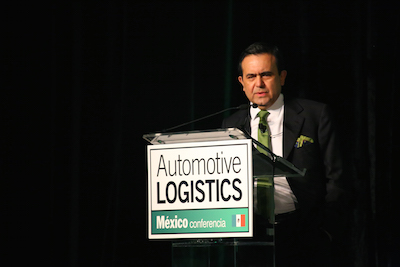
Government officials, along with rail and port providers, pointed to significant investment plans and network designs that should help improve logistics. Ildefonso Guajardo highlighted a new government ‘masterplan’ that has identified needs and planning for logistics infrastructure, including better integration with the US for border crossing, increasing rail and port capacity, as well as developing the south of the country.
“There is an expansion plan for the port of Lázaro Cárdenas, and a new terminal is being built in Veracruz, while we also have a plan for the south,” he said. “A lot of money is being committed to infrastructure for the remaining four years of this administration.”
Dr David Murillo, director general for multimodal corridors and logistics at the Ministry of Communication and Transportation, said that the government’s masterplan identified areas where it will work with industry to develop logistics platforms, including those specific to the automotive industry in Hermosillo, Guadalajara and Silao. He also pointed to large, capital investments in rail infrastructure, including the ongoing construction of a new interchange in Celaya, for example.
Overall, the federal government is running a national infrastructure programme up to 2018. Out of 743 projects under development, 223 are in the transport and communications sector, accounting for $101.5 billion made up of both public and private investment. The National Infrastructure Fund (Fondo National de Infraestructura, or Fondanin), a government agency that provides credit facilities, funding and subsidies, has granted some $8 billion over the past seven years in investments to a variety of public-private partnerships across more than 4,000km of roads and bridges, according to Federico Gutierrez, sub-director of roads and project evaluation.
“We have an investment multiple of more than three times when you combine private investment and financing, and so this accounts for more than $26 billion,” he said.
Investments in infrastructure, education and security gaps are also important at regional levels in Mexico’s federal system. One state that has taken something of a lead in this area has been Guanajuato, where manufacturers have invested significantly in vehicle, powertrain and supplier capacity. Miguel Marquez, the governor of the state, pointed to key infrastructure projects with state support, including the new rail interchange at Celaya, intermodal terminals in Celaya and Silao, as well as an inland port and industrial centre. The state has also been expanding its passenger and freight air cargo services.
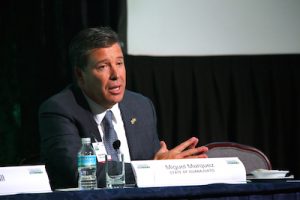 The governor of the state of Guanajuato, Miguel Marquez, pointed to strong state investment in education, infrastructure and security as being important to the state's logistics strengths
The governor of the state of Guanajuato, Miguel Marquez, pointed to strong state investment in education, infrastructure and security as being important to the state's logistics strengths
He also pointed to some M$2.5 billion ($167.5m) in investment in “intelligent security”, including upgrading the state’s fibre optic network and video surveillance systems. The state has been using such systems to improve monitoring of Guanajuato’s state borders to better track who comes in and out of the state.
US-Mexico relations
Along with infrastructure spending, there were also positive signs that the Mexican and American authorities are working more closely together to improve processes and smooth cross-border flows. As well as Mexico’s ‘masterplan’ for infrastructure, Guajardo pointed to efforts to improve aspects of the NAFTA agreements. “We are trying to improve the relationship with North America, but not with the NAFTA 2.0 that has sometimes been discussed. Rather, we are looking at how to improve transaction costs, border crossing, how customs works at the border, and improve harmonisation of standards, as it is completely illogical to ask different requirements of an industry that is working together,” said Guajardo.
Anthony Wayne, the US ambassador to Mexico, who gave a keynote speech, said that there had been increased commitment for both governments to work together, along with state and private entities. For example, a new rail bridge between Brownsville, Texas and Matamoros in Mexico is expected to open in the spring this year, which would be the first new rail crossing between the countries since 1910.
“We are now aiming for April to get it open, but it has been a learning case in how two federal systems can get border projects approved,” said Wayne. “It’s a very complicated mix, including between state, local authorities, the private sector and different train companies. We are really focused on making that work.”
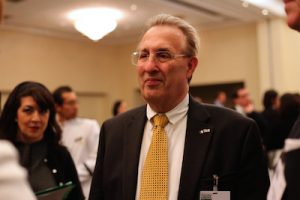
Wayne told Automotive Logistics that the government has also signed agreements to improve customs clearance and border processes. Mexico’s voluntary security approval programme, NEEC, will be recognised as an equivalent certification to the US security and anti-terrorist certification, C-TPAT; after a transition period, companies certified in NEEC will have reciprocal C-TPAT benefits.
There is also an agreement to allow preclearance from inland facilities in the US before releasing material to Mexico. However, before companies can benefit from this agreement, Mexico will have to change existing laws stipulating that only Mexican nationals can clear customs goods into or out of Mexico.
Another example is the recent announcement by the Obama administration that its three year pilot programme to allow a small number of Mexican truckers into the US to deliver goods, rather than changing equipment at the border, would become permanent. Despite initial NAFTA agreements that allowed for cross-border trucking, this move is the first significant step from the US to open up its trucking market to Mexican companies.
“The pilot programme found that all the companies that participated from Mexico had a higher than average safety record than even US companies,” said Wayne. “The administration has announced that those companies have free access to the US. Other interested companies can also apply, and will then be subject to a monitoring period before being approved.”
The number of companies eligible for cross-border trucking so far remains small, and Mexican companies would be limited to making deliveries between the US and Mexico, rather than intra-US domestic moves. But Wayne welcomed the move as an important step towards higher border efficiency.
Wayne also pointed to significant attention and investment in securing the border. “Companies are spending a lot of money to fortify operations and their supply chains, which is money that can be spent other ways,” he said. “We are working to confront these challenges and improve the security environment. We have delivered $1.3 billion to Mexican authorities for security initiatives since 2008.”
Money pouring into rail and ports
The conference also revealed investments from ports and railways. Ferromex and Kansas City Southern de Mexico continue to invest a high percentage of their revenues in capital expenditure: in the case of Ferromex, it is 27%, and some $500m has been approved for the automotive industry over the next five years, according to Alberto Sanchez, assistant vice-president of the automotive business at the railway.

Ferromex provides services along 7,108km of main track with direct services to the US border at five different locations as well as serving eight ports. In addition, Sanchez announced that it is increasing its services at the border with new projects running from Monterrey and Silao.
Ferromex has around 800 locomotives, and has recently increased its multilevel fleet for moving vehicles by 950 wagons, a growth of almost 60%. It currently has a rail market share of 65% and the automotive sector accounts for 13% of its revenue, the biggest sector after agricultural products. Sanchez guaranteed that Ferromex would have the capacity to support the demands of increased production in the country.
Alejandro Couttolenc, from the port of Veracruz, was somewhat less optimistic about the capacity expectations at the port in the near future. When asked if capacity would be sufficient for Mexico’s expected growth over the next 3-5 years, he replied that “we hope to be ready, we expect to be ready” – but acknowledged that capacity would continue to be tight.
The port is nevertheless making some important investments. Priority container shipments can now be handled in 24 hours thanks to better collaboration with the customs services. There is a tax-free storage zone and goods can stay for up to six months. Couttolenc also revealed that the port had plans to develop an area 5km inland of the port for logistics activities.
A new terminal will be built by 2018 with $16m in public investment, and a further $8m provided by private finance. The new terminal would be able to handle larger, post-Panamax vessels.
Plans are also underway to develop a separate rail line that will traverse north of the city and down the coast directly to the terminals, giving each railway at the port separate access, rather than changing onto one line and moving through Veracruz city as today, which hampers the velocity of shipments.
Difficult projects and financing
Despite the positive initiatives and signs of investment, there were some concerns over future investment, particularly from the government. For one thing, around 30% of the federal budget comes from the country’s oil production; with the price per barrel of oil dropping to lows not seen in more than a decade, the government is facing constraints.
“I have to be honest, because 2015 is going to be a tough year [for the budget] because of the price of oil hovering below $55-60 per barrel,” said secretary Guajardo. “The president will do his best to make sure that any reduction in spending will be on existing spending rather than impacting capital investment.”
David Murillo, from the Secretary of Communication and Transportation, admitted that the reduction in the budget was going to make new spending and investment more difficult. “The private sector is going to have to close the gap,” he said.
"The reduction in the budget is going to make new spending and investment more difficult. The private sector is going to have to close the gap" - Dr David Murillo, from the Secretary of Communication and Transportation
Federico Gutierrez, from Fondanin, said that the good news was that Mexico had recently established a new legal framework for establishing public-private partnerships, which should help to address issues around risk and liability for companies investing in Mexican infrastructure. Part of Fondanin’s remit is also to subsidise less profitable or risky infrastructure projects that might otherwise be uninteresting for private investment.
There were also doubts about the authorities’ ability to get projects approved and completed on anything like an effective timeline. One delegate commented that the Celaya bypass project, which had been initiated by the previous government, had already run years late and over budget, and is still less than half completed.
Murillo acknowledged such difficulties, but pointed out that Mexico’s federal structure made it difficult to coordinate complex logistics and infrastructure projects across different municipal and state authorities. “The federal government cannot just act alone to acquire land, as it has to work with local municipalities,” he said. “The plan is to carry out projects in an open and democratic way, as we are not a dictatorship.”
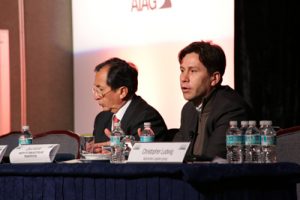
There was some concern over whether the logistics masterplan was in accordance with the needs of different sectors. “I would like to know more details about what the government is doing, and I perceive that the communication between the government and the industry should be closer to ensure the best possible understanding,” said Ford’s Rafael Lopez.
However, Murillo suggested that the government was listening closely, and that the automotive industry in particular has had a strong influence. The Celaya bypass project had been initiated in large part on Honda’s insistence when it decided to build a new plant in the city. Likewise, he pointed to a strong influence from Nissan in building infrastructure in Aguascalientes, as well as for automotive-related projects in the state of Guanajuato.
Free trade and reform benefits
Mexico has a number of positive drivers in both its automotive industry and industrial economy. Ildefonso Guajardo pointed to the country’s openness and participation in free trade as one example, including both NAFTA as well as ten other agreements that cover 45 countries and 1 billion consumers.
Guajardo expressed a keen interest in working with industry leaders to address their needs as well as to understand the industry’s complexities and trade needs, even when it might be politically sensitive. He recognised, for instance, that trying to limit trade and imports from countries like the US or China was not the way to make Mexico more competitive.
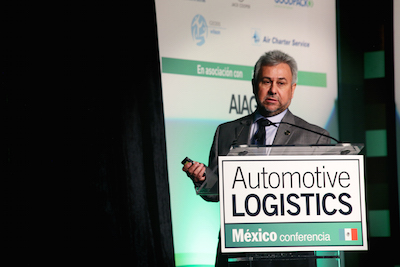
“We have a $50 billion trade deficit with China, but most imports from China to Mexico are intermediate goods that join the value chain to make exports more competitive. We don’t like it, but the question we must ask is how can we bring more value added to Mexican production?” he said. “We cannot be competitive without imports from the US or China.”
He felt that Mexico’s openness to reciprocal trade, somewhat in contrast to Brazil, which Mexico surpassed this year as the seventh largest global vehicle producer, had been important to its success. “Sometimes the electorate is afraid of what is going on in the global economy, and the instinct is for protectionism,” he said. “But we believe that free trade pays back.”
Guajardo also pointed to other competitive factors for the Mexican automotive industry and supply base. Along with a “demographic bonus” thanks to its young population, Mexican and North American manufacturing have been benefitting from the shale gas revolution. “We have an energy bonus in North America, and prices are now set to be a third or even one-fifth those of Asia or Europe,” he said.
This change is significant, as Mexico has historically had higher energy costs than some of its competitors. Guajardo predicted that the lower costs, together with Mexico’s liberalisation of the sector, would lead to a more competitive petrochemicals industry, which could also benefit the automotive supply chain. “With the price of gas and the liberalisation of energy, we are becoming more competitive in areas of plastics, which is important to auto parts as well as to textiles in the interior of cars,” he said.
Such changes would add to what is already becoming an increasingly prosperous tier supply chain. Ford’s Gabriel Lopez pointed to growth of more than 25% among suppliers producing in Mexico over the past four years, with parts supplier revenue reaching $79 billion in 2014. He expects the industry to expand to $90 billion by 2017. Tier suppliers including Cummins, Pirelli and Cooper Standard pointed to increased investment in local production and sourcing in Mexico. At Ford, for example, Mexico is currently the second largest sourcing country for parts globally, after the US, accounting for nearly 14% of its $84 billion parts budget in 2013.
The scale of the Mexican supply base and the progress made in logistics was also exemplified by Delphi’s operations. According to Hector Gutierrez, Delphi now produces more than 13m parts per day, and processes 88m pieces daily from 2,000 suppliers for its 46 Mexican plants. “We ship 20m parts every workday to 8,000 customer locations with a 99.5% on-time delivery performance, and with fewer than two parts rejected per million.
“When you move such a quantity, logistics becomes a foundation for success,” he said.
Oportunidades de comunicación
Among the positives revealed at the event, the conference demonstrated willingness on the side of many stakeholders in the automotive supply chain, including both government and industry, to work together to improve logistics, and make progress towards bridging the gaps between the many different Mexicos.
The participation and interest from the government, in particular, was more evident in Mexico than it has been at other Automotive Logistics conferences.
That did not prevent executives from pointing out where the government should be acting with more urgency, particular around key infrastructure such as rail and ports. For example, although Mexico’s railways were privatised in the 1990s, and are today operated mainly by Ferromex and Kansas City Southern de Mexico, the government still has authority over many aspects of track infrastructure.
Raymundo Garza, head of purchasing for General Motors Mexico, said that the government should do more to address rail and road issues. “We have been having a lot of meetings with the government to address growing shortages in rail infrastructure,” said Garza. “They know what they have to do, and they have to move faster.”
“The government has got to make decisions faster,” added Chris Styles, senior director of logistics for Nissan North America. “We’ve seen this growth coming for years, and we’ve been talking about it.”
But others also emphasised the importance of the industry working together to address common issues, whether in collaboration with officials or private operators. XPO Logistics’ Julie Luna said that there needed to be partnership with customs brokers, third party providers and manufacturers, along with more dialogue in the supply chain.

“There is additional time there to be picked up,” she said. “There are ways of doing business right now that could be changed if we just had more open dialogue across the supply chain.”
Examples she gave included third party providers working to understand how to streamline border crossings as more Mexican truckers were allowed into the US. She also highlighted opportunities for moving more freight within Mexico by rail, including expanding services on the Pacific coast, as well as exploring opportunities to move empty sea containers between the east and west coast by rail to increase shipping capacity.
GM’s Sandoval also highlighted the opportunities of working together with other OEMs and industries to improve network and logistics utilisation, including sharing crossdocks and logistics assets. “We are running a pilot test in San Luis Potosi with another OEM, and are in talks with another one here in Mexico,” he said. “We don’t want to run a standalone network, but find opportunities also with tier suppliers.”
Ford Mexico's MP&L director, Rafael Lopez, said that he saw important gains to be made by working more closely in partnership with logistics providers. "In Mexico, Ford has the strategy to work with lead logistics providers in inbound, in-plant and finished vehicle logistics," he said. "The providers have an improvement opportunity when there is a new model launched or new operations. We need to work more closely with 3PLs.
"I would like to add that our vision for future is that we don't look for suppliers, but rather for business partners," he continued. "We are asking for services in which these providers are the experts. We have preventative systems in place in production, such as andon cords, and we want the same mindset for the 3PLs."
The industry also looks set to benefit from more US-Mexico collaboration, both at the border and beyond. The US ambassador, Anthony Wayne, encouraged delegates to communicate their issues in logistics and supply chain to him and to other business-focused associations, such as the US-Mexico Chamber of Commerce.
“The challenge that we face is that we can’t work if we don’t hear about issues, so contact us and identify things that are important to you,” he said. “There is a lot that we can do together, as the working relations between the US and Mexico have never been better.”
